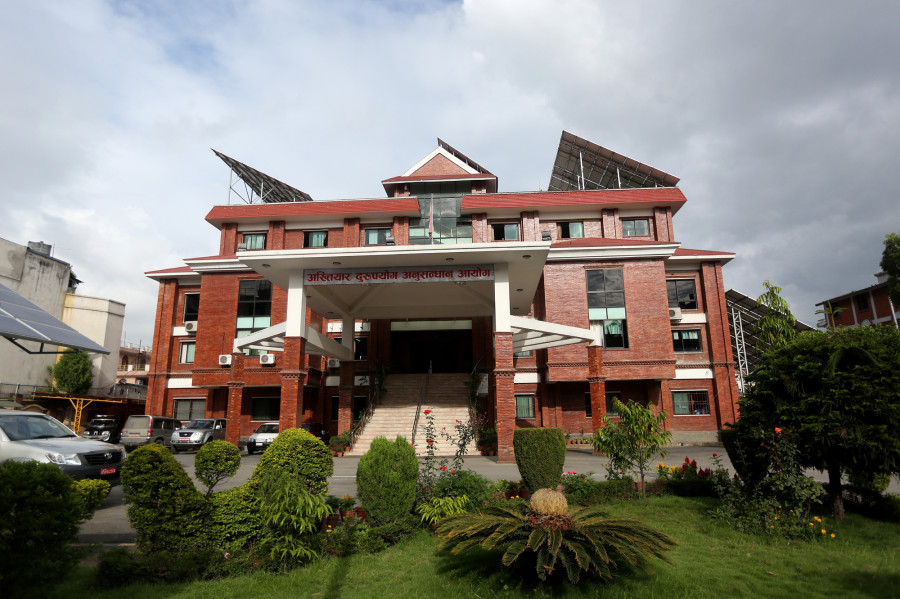National
Corruption thriving at the local level, surveys by anti-graft body show
Experts say office bearers are engaging in a conflict of interest.
Prithvi Man Shrestha
Two recent survey reports about the status of corruption and complaints received by the Commission for Investigation of Abuse of Authority suggest that corruption is thriving at the local level.
It was thought that the country would get accountable governments at the local level after the elected representatives took charge of the governing affairs. But the surveys conducted by the anti-graft body suggest that having elected leadership alone does not guarantee good governance.
A report on Study on Corruption at the Local Level, unveiled by the CIAA on Monday, showed that more than 50 percent of the survey respondents said that corruption at the local level either remained as it was in the past or thriving.
As many as 27.3 percent of the respondents said that corruption at the local level had increased after the local elections. Similarly, another 28 percent of the respondents said that corruption continued to exist like in the past.
Among the respondents, 14.9 percent said they were forced to pay bribes to receive services from their local units.
The anti-graft body had surveyed 3,000 people in 15 districts. Both quantitative and qualitative methods were used for the survey.
Another study conducted last year also showed that local governments were one of the most corrupt institutions in people’s perception.
The survey report, “Study on Corruption and Good-Governance in Nepal-2075”, released in January last year showed that municipalities and rural municipalities were the second most corrupt entities after land revenue offices.
The highest number of respondents (55 percent) termed land revenue offices as the most corrupt while 41.6 percent said they had to pay extra money to receive services from municipalities and rural municipalities.
Khem Raj Regmi, president of Transparency International Nepal, an anti-corruption watchdog, said that one of the main reasons behind thriving corruption at the local level was that politicians in Nepal see politics as a profit-making career.
“The politicians see politics as an easy way to accumulating property,” he said.
Many reports suggest that elected representatives at the local level increased their own facilities— purchasing expensive vehicles and fixing high salary for themselves—instead of serving the public.
With large resources going to local governments, the office-bearers in many local units have been found to have increased their own facilities.
In October last year, the Supreme Court had annulled six provincial laws that allowed office-bearers of local units to draw monthly salaries.
Another reason behind flourishing corruption at the local level is the high cost the office-bearers has to bear to win elections. When election becomes expensive, either a rich person should become a candidate, or one might have to depend on businessmen and contractors.
“Once they get elected, they return the favour by providing contractors with projects and introducing policies to profit the businessmen,” Regmi said.
The estimated poll spending by both—government and the candidates, in local elections stood at Rs69.42 billion while that for the federal and parliamentary elections amounted to Rs62.21 billion, according to a study conducted by the Election Observation Committee, Nepal.
The latest survey of the CIAA also showed that 36.8 percent respondent remarked that corruption flourished at the local level as the elected representatives sought to recoup their election expenditure.
“Currently, local governments are distributing new licences to D class contractors and most of them are relatives of elected representatives or party cadres,” said Rabi Singh, president of the Federation of Contractors’ Association of Nepal.
“Such licences are being distributed without setting any criteria. Inexperienced people who are close to the elected representatives have received D class licences. Meanwhile, experienced sub-contractors are not getting their licences,” said Singh.
He added that some elected representatives, who once worked as contractors, were transferring the ownership of their firms to their relatives so that they could award the project contracts to their own firms without raising suspicion.
As per the Good Governance Act, public officials should not engage in works which invite conflict of interest. But this provision is not being implemented, according to Regmi.
Although the CIAA has been taking action against government employees at the local level, hardly any elected representatives have faced action.
“As elected representatives don’t sign documents by themselves, they usually succeed in avoiding implication. It is similar to the trend seen in the federal government,” Regmi said. “Active intervention from the main opposition parties could help prevent major corruption cases from the government. But in the case of Nepal, there is a tendency of several parties colluding to commit corruption.”
In 2011, the anti-graft commission had scrapped all-party mechanisms formed at the local level in the absence of elected bodies due to many complaints about irregularities through political consensus.
The number of complaints about corruption and irregularities at the local level has risen significantly in recent years, according to the CIAA.
In the last fiscal year 2018-19, the highest percentage of complaints received by the anti-graft body were related to the Ministry of Federal Affairs and General Administration—the line ministry of local units. According to the commission, of the 24,085 complaints received in the last fiscal year, 26.87 percent complaints were related to the ministry.
“Most of the complaints are related to irregularities and corruption at the local level,” Pradeep Koirala, spokesperson at the CIAA, said at a press meet on Monday.
As per the disaggregated data of the previous fiscal years, complaints about the irregularities at the local level are on the rise. The percentage of complaints about irregularities at the local level was 14.6 percent in the fiscal year 2013-14, which climbed to 18.02 percent in the fiscal year 2017-18.




 5.27°C Kathmandu
5.27°C Kathmandu








%20(1).jpg&w=300&height=200)





